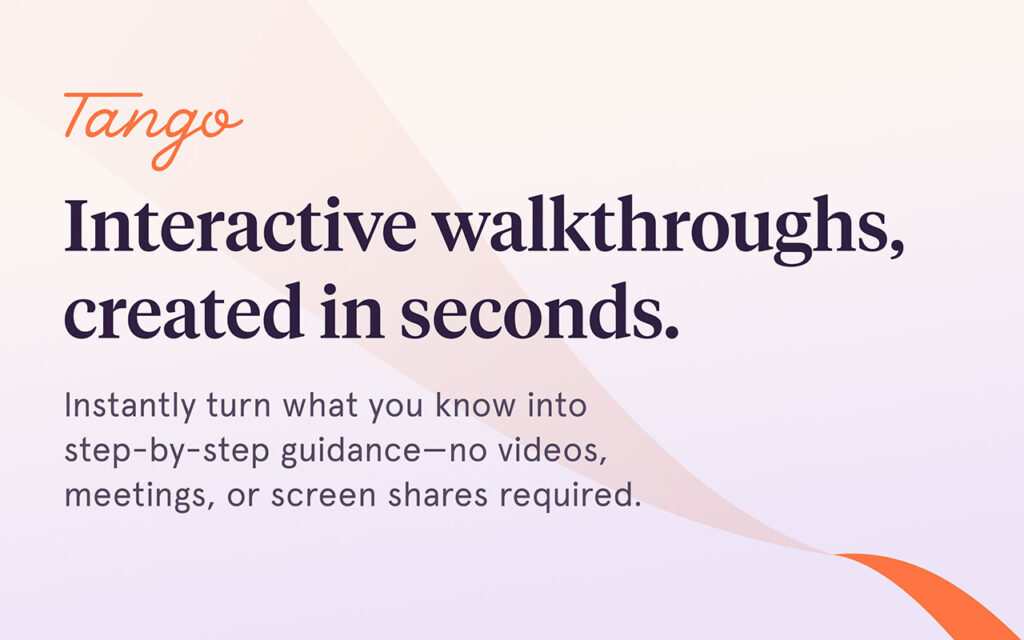
Disclosure: As a reader-supported blog, some of the links in our posts are affiliate links, and if you go through them to make a purchase we may earn a commission. This doesn’t cost you anything extra, but it does help us keep the site up and running with quality content. Thank you for your support!
In the fast-paced digital world, the efficiency of information transfer is paramount. Traditional methods of creating step-by-step tutorials have been the backbone of knowledge sharing, yet they often fall short in meeting the demands of modern efficiency and accuracy. This blog post dives into the traditional process of crafting guides, explores the pitfalls of manual creation, and introduces an innovative solution: Tango, an automated tutorial creation tool. We will unravel how Tango can revolutionize the way we document and share knowledge, making the process more streamlined and effective.
Table of Contents
The Traditional Approach to Creating Step-by-Step Guides
Manual creation of step-by-step tutorials has been the standard approach for years. This method typically involves a detailed process of documenting each step, often with accompanying screenshots or diagrams, to guide the user through a specific task or process. It requires a significant investment of time and effort, with creators meticulously noting down each action and decision point. The manual approach, while thorough, often translates into long hours spent on creating, editing, and updating guides.
However, the digital age demands swiftness and agility, which has led to a critical evaluation of this traditional method. While it has its merits in customizability and personal touch, the question arises: is this the most efficient way to create tutorials in today’s fast-paced environment?
The Inefficiencies of Manual Tutorial Creation
The inefficiencies of creating manual step-by-step tutorials become evident when considering the evolving needs of both creators and users. One major issue is time consumption. Crafting detailed guides manually is a time-intensive process that can distract from other productive tasks. Moreover, the need for constant updates to keep the tutorials relevant with changing technologies or processes adds to the workload.
Another challenge is the potential for human error. Manual documentation is prone to oversights, inaccuracies, or outdated information, which can lead to confusion or misinformation. Additionally, the lack of standardization in manually created guides can result in inconsistencies in presentation and content quality.
In an era where efficiency and accuracy are key, these challenges highlight a growing need for a more effective approach to tutorial creation. This leads us to an innovative solution that addresses these inefficiencies head-on: Tango.

Discovering Tango: The Automated Solution
Tango emerges as a groundbreaking tool in the realm of tutorial creation. It’s an automated solution designed to simplify and streamline the process of making step-by-step guides. Tango allows users to automatically capture each step of a process as it’s performed, creating comprehensive and accurate tutorials with minimal manual input.
This automation brings a new level of efficiency to tutorial creation. With Tango, the time-consuming process of manual documentation is significantly reduced. The tool captures actions in real-time, ensuring that every step is accurately documented, thus reducing the risk of human error. Tango also automatically updates the tutorials to reflect any changes in the process, keeping the content current and reliable.
But what truly sets Tango apart are the added benefits it brings to both creators and end-users of tutorials. Let’s delve into these benefits in the following sections.

Benefits of Using Tango for Tutorial Automation
The introduction of Tango into the world of tutorial creation offers a multitude of benefits that transform the way knowledge is documented and shared. Here are some key advantages:
- Time Efficiency: Perhaps the most significant benefit of Tango is the drastic reduction in time required to create tutorials. By automating the documentation process, Tango cuts down hours of manual work, allowing creators to focus on other critical tasks.
- Accuracy and Consistency: With automation, each step of a process is captured precisely as it occurs, leaving little room for human error. This accuracy ensures that the end-users receive reliable and clear instructions. Additionally, Tango maintains a consistent format for all tutorials, enhancing the user experience with uniformity in design and structure.
- Ease of Updates: Keeping tutorials up-to-date is effortless with Tango. As processes or software change, Tango can quickly re-capture the steps, ensuring that the tutorials always reflect the most current information.
- Scalability: Tango is ideal for businesses or individuals who need to create a large volume of tutorials. Its automated nature makes it scalable, catering to growing or changing needs without additional workload.
- Enhanced Learning Experience: For the end-user, tutorials created with Tango offer a straightforward, step-by-step learning process. The clarity and consistency in presentation make it easier for users to follow and understand complex processes.

Tango’s free plan is perfect for individuals and small teams starting out, offering 15 shared workflows, browser capture, and basic exports and sharing for up to 10 users per workspace at no cost. For more advanced needs, the Pro plan brings unlimited workflows, desktop capture, branded exports, and viewership insights at $20/month per user (billed annually).
For larger teams seeking enhanced features and security, Tango’s Enterprise plan provides comprehensive solutions, including SSO, PII blurring during capture, real-time guidance, and more. And for EfficiencyNest readers, using my affiliate link grants a 25% discount on the Pro subscription and 15% off the Enterprise plan, offering a cost-effective way to access these powerful collaboration and functionality enhancements.
A Practical Usage Example of Tango
To illustrate the effectiveness of Tango, let’s consider a practical example. Imagine a company that frequently updates its software, requiring regular tutorial updates for its employees. Traditionally, this would involve a dedicated team member spending several hours capturing screenshots and writing instructions for each new version.
With Tango, the same process becomes much more streamlined. As the team member performs the task on their computer, Tango automatically captures each step with relevant screenshots and descriptions. This not only saves time but also ensures that the tutorial is an accurate reflection of the updated software. The ease of updating the guide with each software change simplifies the process, making it more manageable and less resource-intensive.
Using Tango at EfficiencyNest for Step-by-Step Tutorials
At EfficiencyNest, we have embraced the power of Tango to enhance our tutorial creation process, and the results have been transformative. By integrating Tango into our workflow, we have been able to produce high-quality, accurate tutorials more efficiently than ever before. This has not only saved us considerable time but also improved the quality and reliability of the information we provide to our audience.
Case Study: “How to Automate Google Forms with Notion”
A prime example of Tango’s effectiveness can be seen in one of our popular blog posts titled “How to Automate Google Forms with Notion“. This tutorial, which guides users through the process of integrating Google Forms with Notion for streamlined data collection and management, was created using Tango.
The process was straightforward and efficient. As we performed each step of integrating Google Forms with Notion, Tango was there to capture every action, automatically generating clear and concise step-by-step instructions accompanied by relevant screenshots. This not only made the creation process faster but also ensured that each instruction was precise and easy to follow.
The final product is a testament to Tango’s capability. Readers of our blog can now access a tutorial that is not just informative but also visually engaging and easy to understand. This has significantly enhanced our readers’ learning experience, making complex tasks approachable and manageable.
The use of Tango at EfficiencyNest demonstrates our commitment to leveraging cutting-edge tools to deliver the best possible resources to our audience. By utilizing Tango, we are not only keeping up with the latest in digital automation but also leading the way in providing top-notch educational content.

Conclusion
In conclusion, the advent of Tango marks a significant leap in the field of tutorial creation. By addressing the limitations of traditional methods, Tango offers a solution that is not only time-efficient but also ensures accuracy, consistency, and ease of updates. Whether for individual creators or large organizations, Tango stands out as an invaluable tool for anyone looking to streamline their tutorial creation process. Its impact on productivity and knowledge sharing is undeniable, making it a must-have in today’s digital-centric world. Tango isn’t just about creating tutorials; it’s about revolutionizing the way we capture and disseminate knowledge in the digital age.

